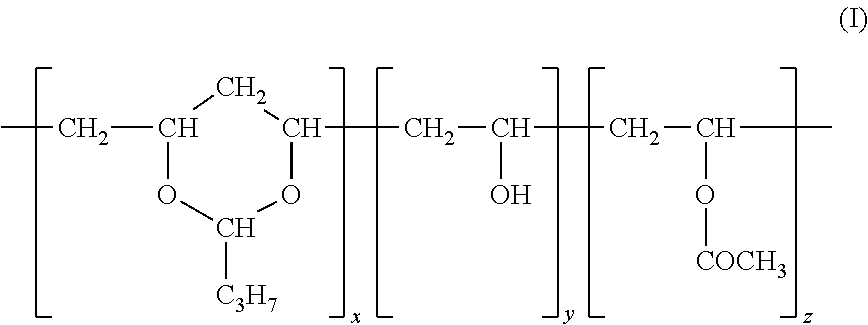Nonwoven fabric formed from polyvinyl butyral continuous fibers, and manufacturing method therefor
a technology of polyvinyl butyral continuous fibers and nonwoven fabrics, which is applied in the direction of melt spinning methods, synthetic resin layered products, chemistry apparatus and processes, etc., can solve problems such as odor generation, and achieve the effects of reducing resin fluidity, suppressing distinct odor, and increasing glass transition temperatur
- Summary
- Abstract
- Description
- Claims
- Application Information
AI Technical Summary
Benefits of technology
Problems solved by technology
Method used
Image
Examples
example 1
[Production of a PVB Powder]
[0050]In a 2 liter glass vessel equipped with a reflux condenser, a thermometer and an anchor type stirring blade were charged 1295 g of ion-exchanged water and 105 g of polyvinyl alcohol (polymerization degree: 300, saponification degree: 98 mol %) and the whole system was warmed to 95° C. for completely dissolving the PVA to prepare an aqueous PVA solution (concentration: 7.5 mass %). With continuous stirring at a rotating speed of 120 rpm, the aqueous PVA solution thus prepared was gradually cooled to 10° C. over 30 min. Then, to the aqueous solution were added 58 g of 1-butanal and 90 mL of 20 mass % hydrochloric acid as a butyralization catalyst (acid catalyst), to initiate PVA butyralization. At the end of butyralization for 150 min, the whole system was warmed to 50° C. over 60 min, then kept at 50° C. for 120 min and then cooled to room temperature. A resin precipitated by cooling was collected by filtration, rinsed with ion-exchanged water (a hun...
example 2
[0056]Using a PVB pellet as described in Example 1, a meltblown nonwoven fabric with a basis weight of 24.5 g / m2 and a thickness of 0.221 mm was produced at the same spinning temperature as Example 1. The nonwoven fabric obtained was used as described in Example 1, to produce a laminate, which was evaluated. The results are shown in Table 1.
example 3
[0060]Using a PVB pellet as obtained in Example 1, a spunbonded nonwoven fabric was produced. Using a spinning nozzle having 1000 nozzle pores with a diameter of 0.4 mm per 1 m width, a resin was extruded at a spinning temperature of 200° C. and a discharge rate per pore of 1.0 g / min, followed by draft drawing. Thus, a spunbonded nonwoven fabric with a fiber diameter of 15 μm, a basis weight of 30.0 g / m2 and a thickness of 0.441 mm was obtained. A time from the beginning of spinning to mass generation was more than 16 hours. Using the spunbonded nonwoven fabric obtained as an adhesion layer, the layer structure as described in Example 1 was formed and pressed under the press conditions: a press temperature of 140° C., a press time of 25 sec and a pressure of 0.2 kg / cm2, to obtain a laminate. The results are shown in Table 1.
PUM
| Property | Measurement | Unit |
|---|---|---|
| temperature | aaaaa | aaaaa |
| temperature | aaaaa | aaaaa |
| pressure | aaaaa | aaaaa |
Abstract
Description
Claims
Application Information
 Login to View More
Login to View More - R&D
- Intellectual Property
- Life Sciences
- Materials
- Tech Scout
- Unparalleled Data Quality
- Higher Quality Content
- 60% Fewer Hallucinations
Browse by: Latest US Patents, China's latest patents, Technical Efficacy Thesaurus, Application Domain, Technology Topic, Popular Technical Reports.
© 2025 PatSnap. All rights reserved.Legal|Privacy policy|Modern Slavery Act Transparency Statement|Sitemap|About US| Contact US: help@patsnap.com

